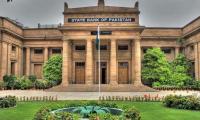ISLAMABAD: To meet the IMF conditions, the caretaker government has revised the GDP growth rate downward from a slight positive of 0.29 percent to a negative -0.17 percent for the last financial year that ended on June 30, 2023.
It was the second lowest growth ever witnessed by the country in the last 50 years, as the highest negative growth achieved by the country stood at -1 percent on the eve of the COVID-19 pandemic. However, the GDP growth rate has turned into a positive trajectory and stood at 2.13 percent for the first quarter (July-September) period of the current fiscal year 2023-24 against a negative growth of -2.7 percent in the last quarter (April-June) the financial year 2022-23.
This data shows that the growth rate under the PDM-led regime was claimed to remain slightly positive at 0.29 percent by the provisional released number, but now, in the finalised figure, it landed in the negative zone of -0.17 percent for the whole financial year 2022-23. According to an official statement issued by the Pakistan Bureau of Statistics (PBS), the National Accounts Committee (NAC) approves the introduction of Quarterly National Accounts in the Statistical System of the Country. The economy witnessed recovery in Q1 2023-24 by posting a growth of 2.13%, as compared to 0.96% in Q1 2022-23. The GDP growth for 2022-23 revised slightly downward from positive 0.29% to negative -0.17%. The 107th meeting of the National Accounts Committee (NAC) to review the annual estimates of Gross Domestic Product (GDP) for the years 2021-22 (Final), 2022-23 (Revised), and quarterly estimates from Q1 2016-17 to Q1 2023-24 was held on Tuesday in the Ministry of Planning, Development, and Special Initiatives (M/o PD&SI). The Secretary, M/o PD&SI, chaired the meeting.
In the 106th meeting of the NAC held in May 2023, the provisional GDP estimates for the year 2022-23 and revised GDP estimates for the year 2021-22 were presented, which are updated based on the latest available data. The final growth rate of GDP for the year 2021-22 has been estimated at 6.17%, which was 6.10% in the revised estimates. The revised growth rate of GDP for the year 2022-23 is estimated at -0.17%, which was provisionally estimated at 0.29%. In the revised estimates, agriculture has significantly improved from 1.55% to 2.25%. Despite the reduction in the production of sugarcane (from 91.1 to 88.0 m tons), important crops have been revised upward from -3.20% to 0.42% due to an increase in the production of wheat (from 27.6 to 28.2 m.tons) and maize (from 10.2 to 11.0 m.tons).
The other crops have declined from 0.23% to -0.93% due to a decrease in the production of green fodder (from 192.2 to 190.0 m.tons), fruits (-5.6%), and oilseeds (-9.7%). Forestry has improved in revised estimates from 3.93% to 14.2% due to higher production reported by the Punjab province. Despite improvement in electricity, gas, and water supply (from 6.03% to 9.84%), the industrial sector growth has declined from -2.94% to -3.76% in the revised estimates due to a decrease in LSM (from -7.98% to -9.87%) and construction (from -5.53% to -9.16%). The services sector growth has also declined from 0.86% to 0.07% due to transportation and storage (from 4.73% to 3.27%), information and communication (from 6.93% to -2.55%), finance and insurance (from -3.82% to -8.09%), public administration and social security (from -7.76% to -8.99%), and education (from 10.44% to 9.94%). In the revised estimates, wholesale and retail trade slightly improved from -4.46% to -4.01%, whereas human health and social work improved from 8.49% to 10.57%.
As an extraordinary step in the history of macroeconomic statistics of Pakistan, the 107th NAC reviewed, examined, and approved the industry-wise methodology of compiling the Quarterly GDP as well as the series of quarterly growth rates of GDP for various industries from Q1 2016-17 to Q1 2023 by taking 2015-16 as the base year.
Later on, the IMF included the QNA compilation in its structural benchmark of the Stand-By Arrangement (SBA) Programme, which stated that “PBS will compile and disseminate the First Quarter estimates for 2023-24 and the revised annual estimates for the financial year 2022-23 by the end of November 2023.” To meet the structural benchmark under the IMF-SBA programme, PBS held meetings with stakeholders and data providers and presented the revised GDP numbers for 2022-23 and Q1 2023-24 before the NAC on November 28, 2023. The committee approved the QNA series from 2016-17 to 2022-23.
The committee also approved the first-quarter estimates of 2023-24 along with data dissemination and revision policy. GVA growth rate of 2.13% has been estimated for Q1 2023-24 as compared to Q1 2022-23. Agriculture has shown a growth of 5.06%, industry 2.48%, and services 0.82%. In agriculture, crops are posting healthy growth of 6.13%, including 11.16% growth in important crops. The major driver for growth in important crops is the increase in the sowing area in comparison with the last year. For instance, the sowing area for rice, cotton, and maize increased by 21%, 11%, and 5%, respectively. It declined by 11% for sugarcane, which is offset by the other three major crops. Industry, after witnessing a continuous decline in three quarters in 2022-23 except for a modest growth in Q2, has changed its direction in Q1 2023-24 by posting a growth of 2.48%. The mining and quarrying industry is showing positive growth of 2.15% based on the quarterly production of the mining sector. LSM growth is based on the Quantum Index of Manufacturing (QIM), which showed a growth of 0.93% in Q1 2023-24. A growth of 0.08% has been reported in electricity generation and distribution, gas distribution, and water supply. The construction industry growth has been estimated at 1.73% based on the output of construction indicators. Production of cement has increased by 15.38% during Q1 of 2023-24 as compared to the same quarter last year.
Similarly, an increase in other indicators has also been witnessed. Iron and steel observed negative growth of 2.20% during Q1 2023-24; however, its impact has been offset by other indicators.
During Q1 2023-24, the overall growth in services is 0.82%. Wholesale and Retail Trade, which is based on the output of agriculture, manufacturing, and imports, has been estimated at 3.05% because of positive growth in agriculture and industry. Transport is showing a growth of 1.7%, which is based on the quarterly data reported by the sources. Information and Communication, which remained negative in most of the quarters last year, has changed its direction by posting 2.4% growth mainly because of a low base and quarterly information received from the sources. The finance and insurance industry has a growth of -12.79% because of the decline in the output of insurance companies, exchange brokers, and mercantile brokers, and also high growth in the deflator. Public administration (which is based on the budget documents of federal, provincial, district, and cantonments/local government) has reported -16.65% growth in Q1 2023-24. Further, a high deflator also resulted in a decline in constant prices. Negative growth in both education and human health and social work activities is mostly driven by the decline in government budget data along with a high deflator. The GDP estimates have been released to meet IMF structural benchmarks under tight deadlines and are based on available information and data. However, as a matter of practice and due to the time lag involved in the finalization of data for the last two fiscal years, the annual GDP estimates are subject to revision in the NAC meeting to be held in May 2024.
Government slashes high-speed diesel price by Rs3.05 to Rs255.38 per litre
CM called on Minister of Communist Party of China and attended luncheon hosted in her honour
PPP chairman underscores nation's resolve to combat terrorism and safeguard future generations
Technology installed as TTS and Hopper is meant to gauge real production of sugar and some other sectors
New flag fluttering over embassy indicates shifting of loyalty by mission in Pakistan to new administration in Syria
This is only way to minimise national turmoil and alleviate suffering of people, says opposition leader Lee Jae-myung







